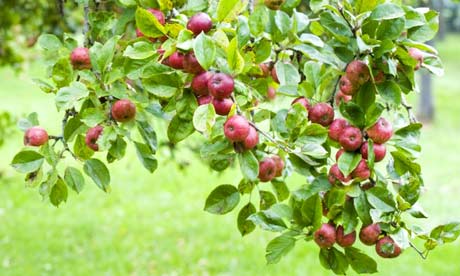
An apple crop being harvested in Somerset. Their price is set to rise this year. Photograph: Mark Bolton/Corbis
Small traditional orchards could vanish from the British landscape by the end of the century unless action is taken to save them, environmental experts and campaigners warned yesterday.
Natural England and the National Trust claimed 60% of England's orchards had isappeared since the 1950s as they launched a £500,000 project aimed at halting the decline. The crisis has been even worse in some areas, such as Devon, which has lost almost 90% of its orchards.
The organisations argued that if nothing was done, a focal point for communities across the country and a crucial habitat for flora and fauna could be wiped out forever.
The loss of orchards would be accompanied by a huge loss of apple varieties, some unique to just a few square miles, and many of them with wonderfully eccentric names such as the Hangy Down, the Oaken Pin and Polly White Hair.
David Bullock, the head of nature conservation at the National Trust, said: "Traditional orchards have been disappearing at an alarming rate. We are in real danger of losing these unique habitats."
Bullock also said that unless more was done to map the many disused orchards in England, rare varieties would be lost, with no records kept of them ever having existed.
In a blossom-filled apple orchard at Killerton, a National Trust estate in Devon, the scale of the crisis was spelled out.
Though cider has grown in popularity over the last few years, it tends to be made from apples grown intensively and treated with chemicals. Many smaller traditional orchards have been built on, or uprooted to make way for arable crops and pony paddocks.
That meant the loss of habitats for birds, beetles including the threatened Noble Chafer, mammals — such as long-eared bats — moths, lichens and fungi.
For the purposes of the new £500,000 project, traditional orchards are defined as having at least five trees widely spaced and allowed to grow gnarled, hollowed and eventually fall where they stand . They are not intensively managed, are treated with few or no chemicals and are often grazed by animals such as sheep or geese or cut for hay.
Lucy Cordrey, the project manager, said: "Traditional orchards have become an extremely rare and precious habitat. We need to do something to stop this decline. Orchards bring people and wildlife together. It's about food, the culture behind them, the heritage. They are magical places to be in."
Under the two-year project old orchards are being restored and long forgotten or neglected ones rediscovered and mapped. Workshops are being set up to train people in skills such as pruning and grafting and communities are being told how they can revive old orchards, plant new ones and market the fruit they produce.
Sue Clifford, director of the environmental charity Common Ground, said she was confident the traditional orchard would be saved.
Clifford, whose favourite apple is the west country's Slack-ma-Girdle, said: "The interest is escalating. In the last two or three years we've seen a change in people's attitudes.
"We've been trying to excite people since the late eighties about traditional orchards. We've tried to say to them, look there's 2,300 varieties of eating and cooking apples, several hundred more of cider apples. And that's just apples. Think of the pears and the plums and the
damsons. And I think people are starting to realise that orchards are beautiful places. They are fantastic for wildlife and they are good for community spirit. "
Traditional orchards, traditional apples
Here are just a few of the varieties of apples to be found in the orchards of the Killerton estate in Devon:
Killerton Sweet
Unique to Killerton, a pale green cider apple. One of the varieties used in the estate's popular 6% cider.
Killerton Sharp
Also found only at Killerton. A little drier and sharper than the sweet, and gives the cider a bit of bite. Ripens in October.
Philbert Nut Bush
A bright red Somerset apple. Excellent in chutney but also makes a tasty desert apple.
Star of Devon
Originally from the village of Broadclyst just a few miles away from Killerton. A pale yellowy-green pithy apple.
Ten Commandments
Split it in two and you find 10 brown dots - hence the name. Pale green and yellow, becoming red as it ripens in late September and early October.


